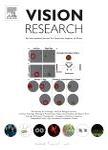版权所有:内蒙古大学图书馆 技术提供:维普资讯• 智图
内蒙古自治区呼和浩特市赛罕区大学西街235号 邮编: 010021

作者机构:McGill Univ Dept Ophthalmol Montreal PQ H3A 1A1 Canada
出 版 物:《VISION RESEARCH》 (视觉研究)
年 卷 期:1998年第38卷第6期
页 面:827-840页
核心收录:
学科分类:0402[教育学-心理学(可授教育学、理学学位)] 1002[医学-临床医学] 1001[医学-基础医学(可授医学、理学学位)] 100212[医学-眼科学] 10[医学]
主 题:spatial alignment spatial coding contour orientation
摘 要:Several workers have concluded that Gabor alignment tasks are performed by using central tendencies of the micropatterns as a cue, One reason for this conclusion was that the 3-Gabor alignment task is performed equally well whether the orientations of the patches are collinear or orthogonal to the group orientation, We wished to find out if the orientation of the micropatterns has any effect on performance, We tested subjects in 3-micropattern alignment tasks using a variety of orientational conditions, If three vertically-aligned Gabor patches were vertical, horizontal or both, or if bullseye or Gaussian blobs were used, no difference in performance was found, If, however, the orientation of the patches was randomized, performance became much worse, Similarly, if the three patches were at 45 deg, thresholds were raised, The effect of orientation was maintained across different spatial frequencies, Control conditions involving randomization of the phase of the sinusoidal carrier, or jitter on the size of Gaussian blobs, confirmed that a central tendency of the micropatterns was indeed being used by subjects, indicating that the role of orientation in this task is that of a mask, rather than of a cue. (C) 1998 Elsevier Science Ltd. All rights reserved.